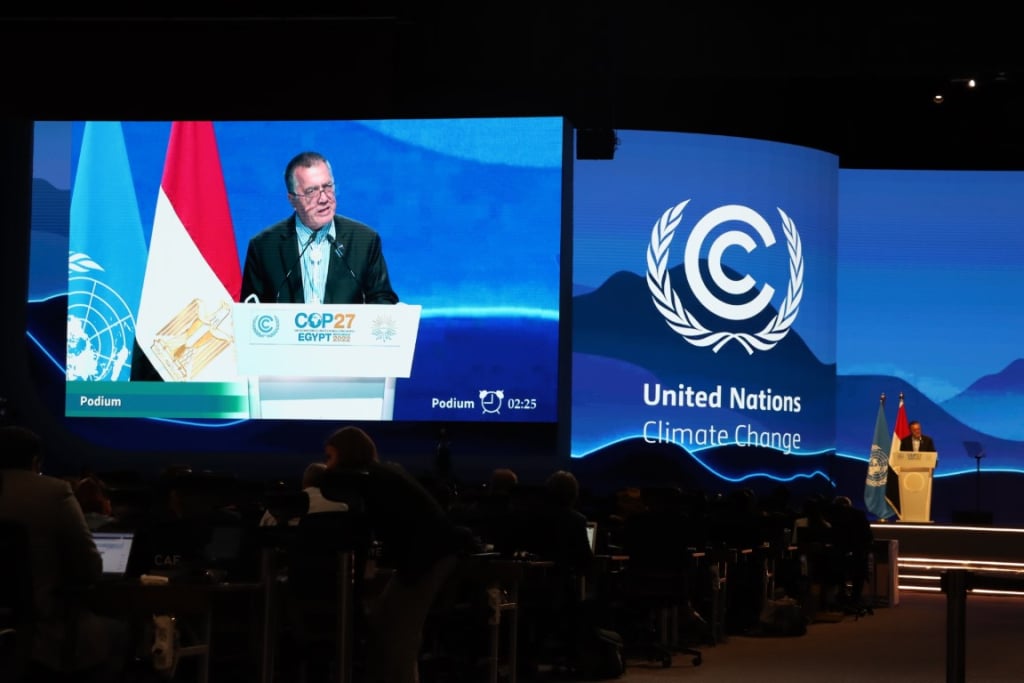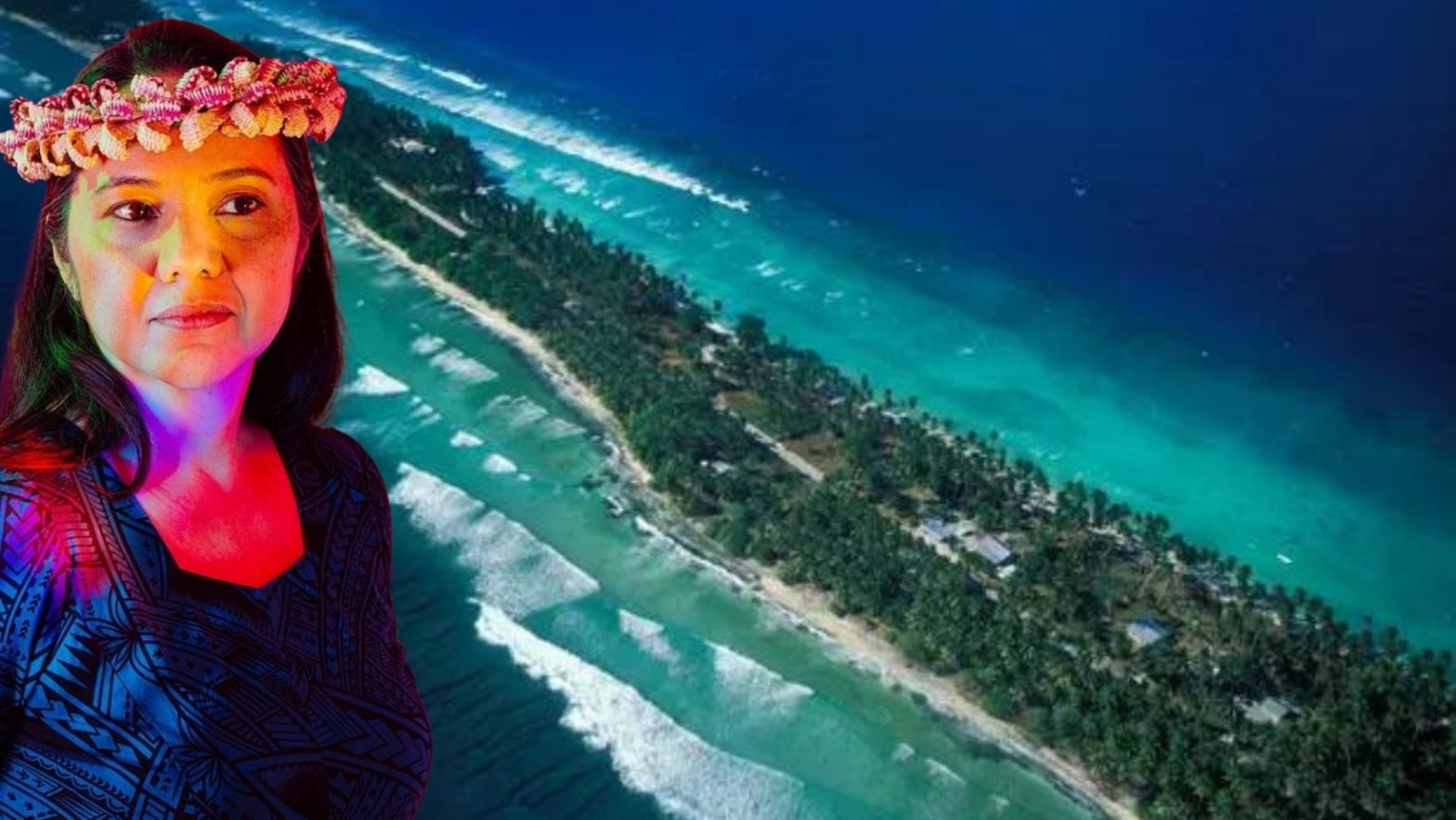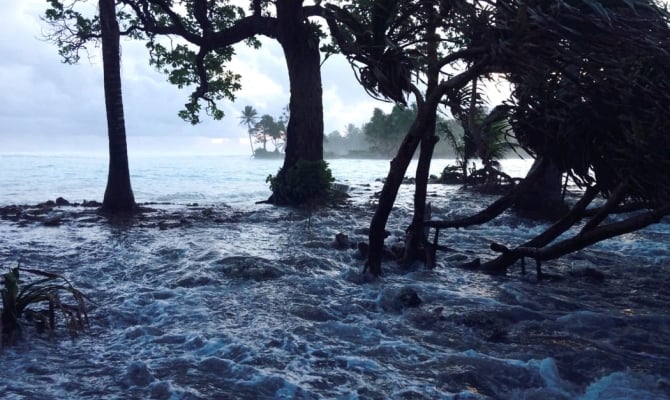Marshall Islands is uniquely at risk for climate change, islets are disappearing, and it is so dire that we’ve been forced as a nation to completely change the way we plan for our future, writes Kathy Jetn̄il-Kijiner.
Ellekan, an islet in Marshall Islands, has been reduced to a pile of sand in the middle of the reef. Those who loved it have already held its funeral.
On a trip to the islet of Kalalen, eight years ago, a man named Yoster Harris ran out to meet me.
Yoster is married to the alap, or landowner, of Kalalen and he took my hand and led me to point out Ellekan, a neighbouring islet at the very end of the Majuro atoll lagoon, in my home of the Marshall Islands in the north Pacific.
It didn’t look like much. Just a pile of sand in the middle of the reef. It looked like a sandbar.
It used to have trees, he assured me. Just five years before there had been trees and he used to camp there, and pick the bob, the pandanus.
“It’s dead,” Yoster told me. “We’ve already had its funeral. But you need to save the others.”
A funeral for an island. This line has stayed with me for years. It burrowed itself under my skin and lived dormant in my body. I washed it through the roof my mouth and allowed it to emerge on stage while I was speaking to foreigners who could not possibly know what an atoll looks like.
How do we properly mourn an island? How do we grieve and process the sorrow? If we follow the proper protocol of Marshallese funeral rites, then there are a number of steps needed.
There would need to be a viewing – something similar to what has been described to me in the U.S as a wake. People who knew the island would have to arrive in black – men in black suits, women in flowing black dresses. There would be fold-out chairs lined in rows, and a pastor to speak on the life of the islet, who they are.
There would be songs to honor this islet and what they gave us. Afterwards, we would line up and shake the hands of the Irooj, the high Chiefs, the Alap or the landowners, and then the families related or tied to the islet.
There would be cups of Kool-Aid for the mourners on their way out, and to-go tuna sandwiches packed in ziplock bags. And then after the wake, there would be a burial. And a few days after, the eorak, the final funeral rite when we revisit the grave.
But how does one bury an islet? Where do we mark the grave? And how will we remember the islet long after it’s been gone?
Runit dome, the island that is a nuclear waste site, has often been called a tomb by the Enewetak islanders. Runit was once an island which was obliterated by a nuclear weapon during the US nuclear weapons testing program. It then became a crater, before US workers shovelled nuclear waste into it and capped it with a concrete dome. And now, this dome is said to be leaking nuclear waste because of the rising sea level. I’d rather not memorialise Ellekan in this manner.
The entire Marshall Islands is uniquely at risk for climate change as one of the few atoll nations in the world.
Atolls are a type of island that have no mountains, are completely flat, and are essentially coral that has grown around the rim of a volcano sunken over thousands of years. Songs have described them as a string of pearls floating on the ocean. They have a unique vulnerability to climate change that sets our islands apart from the rest of the Pacific and other island nations.
The science has become so dire that we’ve been forced as a nation to completely change the way we plan for our future. The development of our national adaptation plan has been a key focus on the ground for the past few years and has been a part of my work as climate envoy. We call it our survival plan.
It’s a plan that considers adaptation pathways, such as possibly building new islands, elevating parts of islands and relocating communities within our islands. It’s a massive undertaking that will require input across all our islands, communities and sectors.
During a meeting, one of our leaders admitted our capital city may need to change. Imagine that. Imagine changing the location of your capital city due to climate change, as if we’re just moving houses. But we’re not just moving houses. We’re considering changing ancient customary land laws, arguing for loss and damage financing to go towards preservation of cultural stories rooted in shorelines that are disappearing. The worst case scenario is already here.
But never mass, forced relocation. We’re doing everything we can to keep our country and our lands.
Naming children after our ancestral parcels of land has become a bit of a trend here, my cousin noted recently.
My daughter’s name is Peinam. She is named after a parcel of land situated on Mejrirok, an islet of Jaluit atoll. It’s our lamoren, or our clan’s land passed down through generations from our maternal side. It’s a land where my mother lived, and her mother, and her mother – our homeland, situated across from a brackish salt water pond, one of the rare few in the country. Who we are is tied to this piece of land.
Mejrirok also holds significance as a burial site for the chiefly domain of Litokwa, one of the four domains in the Ralik chain. Other children’s names include Mejatto, Bokaitoktok, Patto. Children with thick legs and full tummies, ambling around bearing the history and name of these ancient islands we call home. When we consider what can be lost due to climate change, I think of Peinam, this precious land my daughter is named after. And I think of Ellekan, of what has already been lost.
This opinion is by Kathy Jetn̄il-Kijiner, originally published at The Guardian on 01 November 2022, reposted via PACNEWS.



